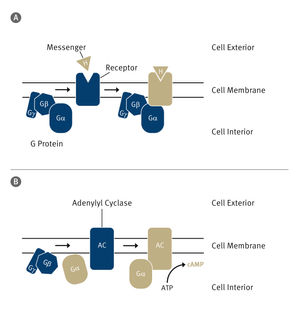Structure of CCR9 chemokine receptor solved
Offering opportunity to apply structure-based design across chemokine receptor family
Heptares Therapeutics announces that its scientists have solved the high-resolution X-ray crystal structure of the CCR9 receptor, a member of the chemokine receptor family. This family of G protein-coupled receptors (GPCRs) has diverse roles in immune defence by controlling the migration, activation and survival of immune cells, hence chemokine receptors are important drug targets in a wide range of diseases. The CCR9 receptor itself is central to leukocyte (white blood cell) recruitment to the gut and represents a therapeutic target in inflammatory bowel diseases, an area of increasing interest for Heptares.
Fiona Marshall, Chief Scientific Officer at Heptares and at Sosei, commented: “The availability of a high-resolution structure of the CCR9 receptor in this conformation provides a unique opportunity to apply structure-based drug design to the discovery and optimisation of selective small molecule allosteric modulator drugs not only targeting CCR9 but potentially also other members of the chemokine receptor family. This new structural information adds to the wealth of information the Company has generated using its StaR® platform on GPCRs, and is enabling the Company to apply its structure-based design platform to develop a sustainable pipeline of novel drug candidates in diverse disease areas.”
The publication describes how Heptares scientists solved the X-ray structure of the CCR9 receptor bound to the selective antagonist vercirnon. The research revealed that, surprisingly, vercirnon binds to the intracellular side of the receptor and not to the normal binding site for GPCR ligands. In binding to this allosteric site on CCR9, vercirnon exerts its antagonistic effect by preventing CCR9 from interacting with signaling molecules inside the cell. This breakthrough finding has opened a new avenue for investigation across the chemokine receptor family. Heptares scientists have previously identified allosteric binding sites on other GPCRs including the glucagon receptor.
Only two drugs that target chemokine receptors from over 50 entering clinical development have reached the market: maraviroc for HIV targeting CCR5, and plerixafor for stem-cell mobilization targeting CXCR4. The low success rate is thought to be in part due to limited understanding of the mechanisms of action of chemokine receptors, and an inability to optimise candidate compounds in the absence of structural information. Heptares believes that the new information has the potential to improve the success rate of efforts to develop small molecule therapeutics against chemokine receptors.
Original publication
Christine Oswald, Mathieu Rappas, James Kean, Andrew S. Doré, James C. Errey, Kirstie Bennett, Francesca Deflorian, John A. Christopher, Ali Jazayeri, Jonathan S. Mason, Miles Congreve, Robert M. Cooke & Fiona H. Marshall; "Intracellular allosteric antagonism of the CCR9 receptor"; Nature; 2016
Ali Jazayeri, Andrew S. Doré, Daniel Lamb, Harini Krishnamurthy, Stacey M. Southall, Asma H. Baig, Andrea Bortolato, Markus Koglin, Nathan J. Robertson, James C. Errey, Stephen P. Andrews, Iryna Teobald, Alastair J. H. Brown, Robert M. Cooke, Malcolm Weir & Fiona H. Marshall; "Extra-helical binding site of a glucagon receptor antagonist"; Nature; 2016
Most read news
Original publication
Christine Oswald, Mathieu Rappas, James Kean, Andrew S. Doré, James C. Errey, Kirstie Bennett, Francesca Deflorian, John A. Christopher, Ali Jazayeri, Jonathan S. Mason, Miles Congreve, Robert M. Cooke & Fiona H. Marshall; "Intracellular allosteric antagonism of the CCR9 receptor"; Nature; 2016
Ali Jazayeri, Andrew S. Doré, Daniel Lamb, Harini Krishnamurthy, Stacey M. Southall, Asma H. Baig, Andrea Bortolato, Markus Koglin, Nathan J. Robertson, James C. Errey, Stephen P. Andrews, Iryna Teobald, Alastair J. H. Brown, Robert M. Cooke, Malcolm Weir & Fiona H. Marshall; "Extra-helical binding site of a glucagon receptor antagonist"; Nature; 2016
Topics
Organizations
Other news from the department science

Get the analytics and lab tech industry in your inbox
By submitting this form you agree that LUMITOS AG will send you the newsletter(s) selected above by email. Your data will not be passed on to third parties. Your data will be stored and processed in accordance with our data protection regulations. LUMITOS may contact you by email for the purpose of advertising or market and opinion surveys. You can revoke your consent at any time without giving reasons to LUMITOS AG, Ernst-Augustin-Str. 2, 12489 Berlin, Germany or by e-mail at revoke@lumitos.com with effect for the future. In addition, each email contains a link to unsubscribe from the corresponding newsletter.


























































